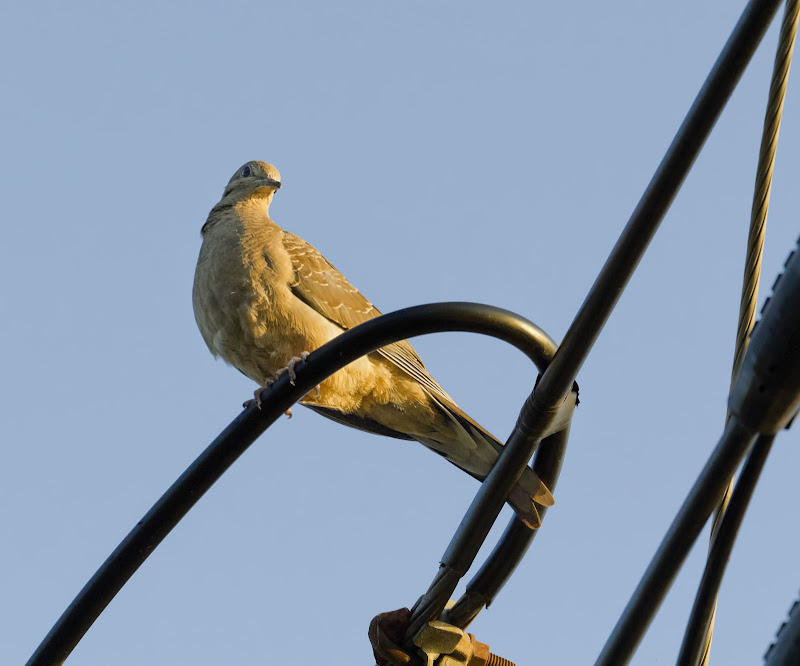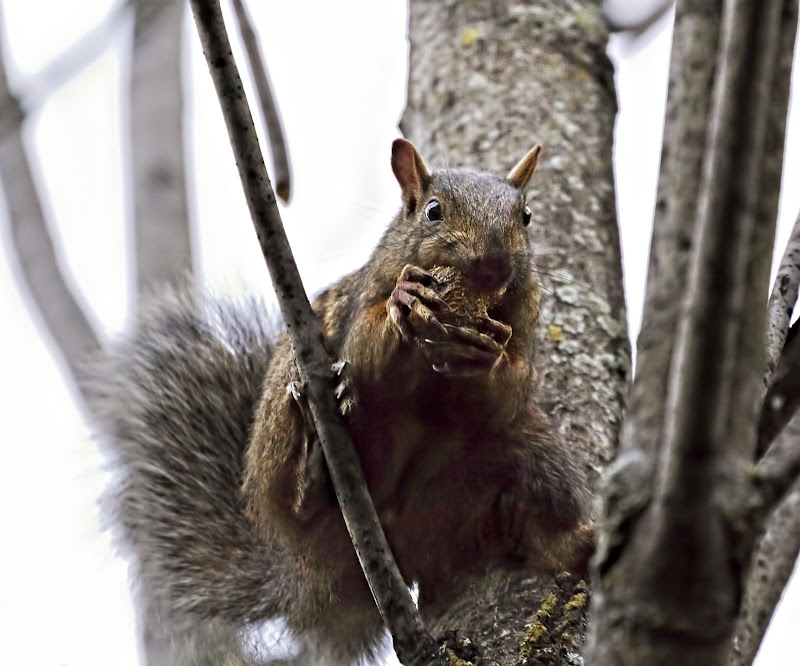After seeing Carl's work and further edit by Teamspeed at Iso 6400 with corrected image I got in touch with Carl who pointed me to a couple of discussions both here and in other forums.
Thanks Carl and Teamspeed.
What struck me was that almost all the samples were "controlled" ie mostly static, indoors, artificial lighting etc. While the theory looked promising the examples were not quite as real-world as I would have liked. 99% of those shots could have been easily done well with just a touch of flash.
Armed with that info off I went to do wildlife with high isos. Waited until the sun had set but still have sufficient light for a reasonable exposure. There were a couple of objectives to be met - there must be movement, patchy lighting with areas of very bright and dark, darkish main subject, f5.6 or tighter.
Base working exposure - ISO 800, f8 or f5.6, 1/200 or 1/160. These setting provide a good exposure for the conditions but could not take account of movement. So with the higher isos it was more to get the speed up a few notches and not so much to compensate for lower light. Of course as the evening progressed light did decrease rapidly and had to be compensated for (squirrel in tree shot for example).
The 550D has at the higher ISOs 1600, 3200, 6400 and the expansion ISO 12800.
Here are the results.
They look reasonable but probably doubtful for large size printing. Web display or maybe 12x8 should be the max imho. The only downside is that they do require a bit more careful post processing ie more steps.
1. 1600, f8, 1/1000
2. 3200, f8, 1/1250. Objective was to freeze the ripples.
3. 6400, f5, 1/1000. Objective was to freeze the droplets and puddle of water.
4. 6400, f5.6, 1/125. Low speed. Note loss of definition on underside and nose.
5. 6400, f5.6, 1/3200. Objective was to freeze the swimming movement. It is surprising how fast a turtle moves his legs in water. The one on the left was going full steam toward the other one. Waited until both were in frame before firing.
6. 12800, f5.6, 1/2500. Should have tested at lower speeds and smaller apertures but forgot.
Will try that sometime this week.
6a. SOOC, default ACR settings, sharpening off
6b. 100% crop.
6c. Processed.
Results 1 to 7 of 7
Thread: High ISOs
-
24th September 2012, 08:24 PM #1

- Join Date
- Apr 2011
- Location
- Ontario (mostly)
- Posts
- 6,667
- Real Name
- Bobo
High ISOs
Last edited by Bobobird; 24th September 2012 at 08:36 PM.
-
24th September 2012, 08:27 PM #2
Re: High ISOs
Impressive, Bobo. I love the turtle shot!
-
24th September 2012, 08:54 PM #3

- Join Date
- Dec 2011
- Posts
- 780
Re: High ISOs
Your Welcome Bobo, it is a learning curve for all of us that is interested and I hope to learn something more from you today.
They are all good to me. I would say if not higher ISO's then the shots would not have come out so good unless flash was used, if possible.
Could you tell your PP steps of the last one (6c) it is really outstanding in sharpness, color and detail? As far as I can see. Just to clarify this one was shot at 12800?
The main reason I wanted to learn all I could about higher ISO's and ETTR was to shoot in an area (indoors) without flash as it distracted folks. But to capture the action I had to get the shutter speed up to keep from having blurry shots or partial blurry shots also to keep from having dark shots and have to lighten in PP which was disastrous on the noise level in shadow areas especially.Last edited by Carl in Louisiana; 24th September 2012 at 09:26 PM.
-
24th September 2012, 11:37 PM #4

- Join Date
- Apr 2011
- Location
- Ontario (mostly)
- Posts
- 6,667
- Real Name
- Bobo
Re: High ISOs
Thanks Phil.
Thanks Carl. Yes, that is a 12800.
Couple of things wrong there - shutter speed too high 1/1000-1/1600 would have been more correct.
High ISOs do a couple of things - generate lots of noise, lose dynamic range and soften details.
Noise - no matter how well you expose there will be noise. The trick as you know is to turn that noise from "dirty" to "clean". That is where ETTR comes in. In this particular shot I may have turned the wheel by accident. The s/s setting for the previous couple of shots was certainly not 1/2500. So in a way this shot is under-exposed and not ETTR.
NR - colour noise, looked pretty awful so set that that 100/50 in ACR, also set luminance NR to 25/50. Further noise processing by viewing individual channels etc but ultimately applied a bit more NR on the shadows and slightly less on the midtones and very little on the highlights.
Loss of DR - I used an adjustment layer and pushed up the vibrance and saturation of only the duck'ss backend and the yellow circle around his eye.
Softening of detail - a high iso shot is not a great candidate for normal sharpening due to lots of blocky speckles. What I did was make it "appear" sharp by using levels and curves.
Sharpening - a very tiny bit of USM in PS. 200/0.3/0 at the very end on the duck only.
Final step - 1 further NR pass over only the water portions.
On the 550D (1.6 crop) going that high is just pushing it imho. Reasonable shots yes, but the pp time is correspondingly much longer and more tedious.
As for shooting indoors without flash - high iso is not a cure for bad light. You must be able to get a proper ETTR'd ( +2/3 or +1) exposure at a reasonable ISO and shutter speed. For sport you are looking at a minimum of 1/1000-1/1250 ETTR.
In most of my shots I pushed the ISO up 1 or even 2 without changing either the ss or aperture and making sure not to blow. By pushing ISO by 2 there was still a little leeway for a slightly faster shutter or a slight smaller aperture.Last edited by Bobobird; 24th September 2012 at 11:56 PM.
-
25th September 2012, 12:03 AM #5

- Join Date
- Dec 2011
- Posts
- 780
Re: High ISOs
Just to look at the duck I would never have thought that the ISO would have been that high
 . I really need to get back at it and play around to see what else can be done.
. I really need to get back at it and play around to see what else can be done.
I did sneak up on the kingfisher this morning as close as I thought I could but it was awful when I put it on the computer. I did learn I'll have to sneak up closer next time.
You have certainly done your homework and it has payed off big I think. I wonder what sizes you can print it at before the noise begins to spoil it?
Great work there and thanks for sharing your PP steps.
-
25th September 2012, 12:38 AM #6

- Join Date
- Apr 2011
- Location
- Ontario (mostly)
- Posts
- 6,667
- Real Name
- Bobo
Re: High ISOs
Sneaking up on a kingfisher??? Hardly possible and that is what 800mm lens are for.

Print not sure but print is more forgiving the web - will have to try it out later. Probably 12x8 should be ok but larger will be a problem.
-
25th September 2012, 12:52 AM #7

- Join Date
- Dec 2011
- Posts
- 780

 Helpful Posts:
Helpful Posts: 








 Reply With Quote
Reply With Quote

